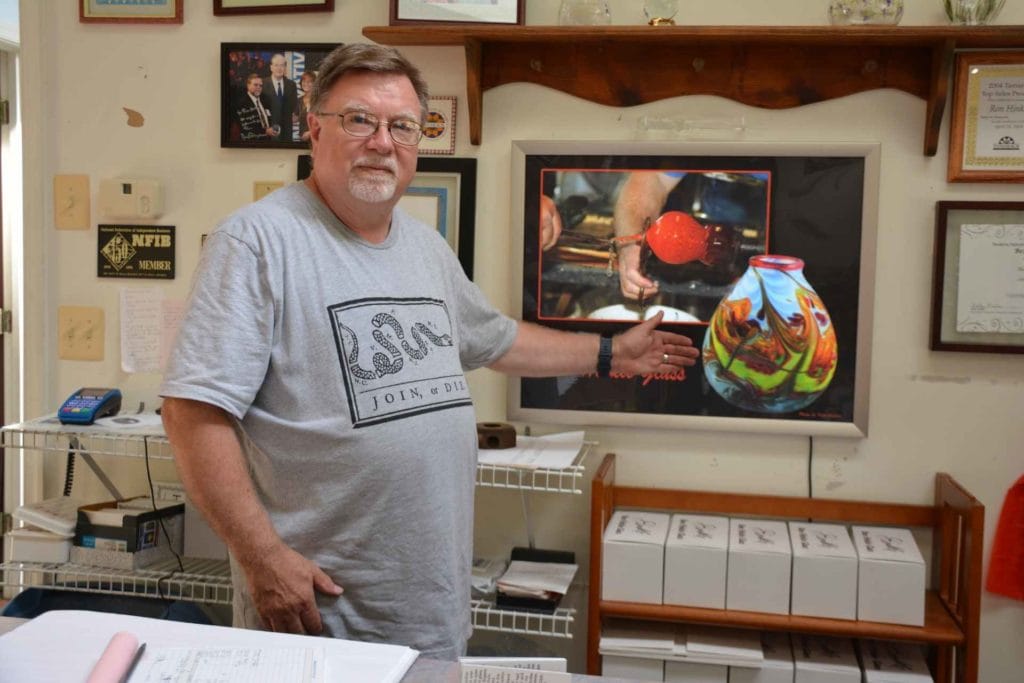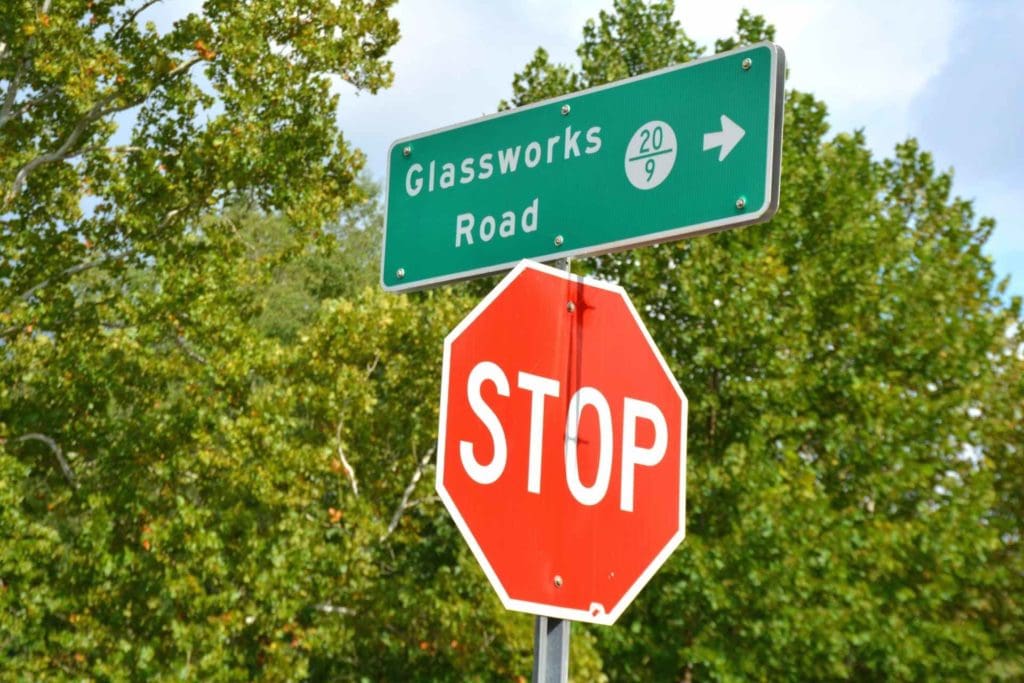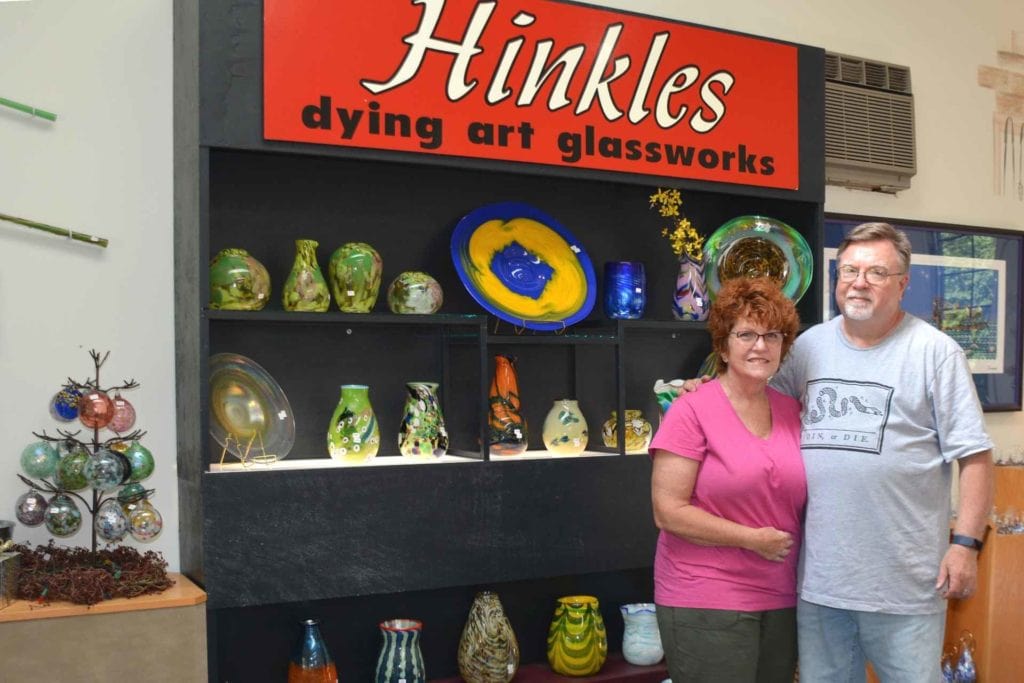SAGO – Most times, Ron Hinkle works without a mold, utilizing a technique known as free-handed glassblowing.
That means when the acclaimed master glass artist retrieves his vividly-colored creations from the furnace at about 2,030 degrees Fahrenheit, he doesn’t use a pre-drawn mold or cutout to guide his artistic process. Instead, he employs a variety of hand tools to coax them into the shapes he envisions. He’s always liked how malleable molten glass is, he says on a late Tuesday afternoon at his residence on Glassworks Road, home to both his studio and gift shop.
“It’ll flop over; you’ll lose control of it,” he described. “It’ll drip onto the floor, and then it cools off a little bit and then it’s like honey. Then it cools off a little bit more and it’s like taffy, so it goes through all these stages, and you have to figure out: ‘What do I do first on that piece of glass to get it to cooperate and end up in the shape I want it to before it gets too cold to work with?’”
Over the past 49 years, Hinkle has sold his unique, polychromatic pieces – including glass vases, Christmas ornaments, tumblers, paperweights, lampshades and more – in over 37 states and six other countries. Within the next several months, though, he’s preparing to turn off his furnace and kiln for good. The award-winning Upshur County native plans to retire in early 2023, and already, he’s no longer performing glass-blowing demonstrations or accepting custom-made or wholesale orders.
Glass-making magic
Hinkle thinks he’ll be at peace with his decision to retire when the time comes. But when he’s describing the glass-blowing process, the sparkle in his eyes when he says, “and then it’s like honey” conveys the sense of wonder glass-making inspires – and has always inspired – in him. It evokes an image of a small child who can’t sleep on December 24 because Christmas Eve magic pervades the air.
“I’m definitely going to be sad, but I am really feeling like I can make peace with it,” Hinkle said. “If I worked until July of next year, it would be 50 years, but it just seems like the time is right now for us to shut down. It seems like we’ve got so many doctors’ appointments, I hardly get to work. I have aches and pains and I have problems with my hands and the tendons in my elbows.”
Hinkle said Betty, his wife of 29 years, has been his greatest support, logging thousands of hours assisting her husband with shows and miscellaneous tasks throughout his artistic career. She’s noticed that more and more frequently, Hinkle will come in the house after a long day, and it’s evident he’s in pain.
“We’re getting older, and things are starting to fall apart,” she said. “There’s a lot of repetitive motion involved in glass-making.”
Once he retires, though, Hinkle will still have a creative outlet through an ongoing consultant role at Blenko Glass in Milton, West Virginia, where he served as the vice president of operations for a couple of years.
“I may be called down there from time to time on special projects, so that’s a great honor,” he said.
The history of Ron Hinkle Glass
Hinkle took his first job as a glassblower at Louie Glass in Weston in 1973 and honed his skills there for 20 years before he left in 1993 to establish Hinkle’s Dying Art Glassworks, which opened in early 1994 and eventually transitioned to Ron Hinkle Glass in 2005.
People mistakenly imagined the ‘Dying’ in ‘Hinkle’s Dying Art Glassworks’ meant Hinkle dyed clear glass to achieve the vibrant color combinations mixed into the dapples and swirls that characterize his work, but that’s not the case. He has over 145 colors of crystallized glass stocked in large jars in his studio, so there’s no dyeing involved; rather, the name indicated the art of glassmaking was literally diminishing – dying off – when he opened his studio and shop in 1994.
About a decade later, Hinkle’s stepson, Tom O’Neill, advised him to change the name to Ron Hinkle Glass, saying the “Dying Art” part of his enterprise “might seem kind of morbid to some people,” Hinkle recalled.
“He told me, ‘this is about you,’ and so I made it about me, and then I started signing my designer vase pieces,” Hinkle said. “So, it was a good directive he gave me.”
Never-ending nuances
To Blenko Glass Co. operators, the breadth and depth of Hinkle’s experience in the highly specialized field of glass-making make him an ideal candidate to train new and up-and-coming glassblowers, he said.
“Glassblowing has been compared to an Olympic sport because it takes years to learn the nuances of it,” he said. “Every tiny movement you make – how you spin the pipe, whether you’re holding it elevated, level or down, whether you’re turning left or right – affects what you’re making, so you have to learn these things slowly.”
Hinkle’s curriculum vitae isn’t too shabby, either. His impressive list of awards includes such honors as having been named one of the 10 Most Outstanding Small-Scale Manufacturers in the Mountain State by then-U.S. Senator Jay Rockefeller; receiving recognition for Excellence in Support of the Arts at former W.Va. Governor Earl Ray Tomblin’s Governor’s Arts Awards Gala; earning multiple accolades at Tamarack, including awards for Best of Show and Lifetime Achievement; and another Lifetime Achievement Award from the Fairmont Arts Society.
One of Hinkle’s most distinct honors is having inspired the choreography for the dance routine, “Catching Light” performed by the West Virginia Dance Company about the history of glass-making in Appalachia.
His artistic style stands out – and his pieces outsold Blenko, Masterpiece Crystal and Fenton Glass and other large-scale glass manufacturers at Tamarack – due to a shift in how customers conceptualized glass-making.
“People were wanting art instead of mass-produced glass,” Hinkle said.
Hinkle never set out to attain such wide acclaim, he said, but was instead simply focused on earning a living.
“All of this happened not because I was trying to make it happen,” he said. “I just wanted to make a living and make beautiful things.”
Two keys to his success? A deep-seated desire and repetition, repetition, repetition, which began at his first job at Louie Glass.
“We would work in teams, sometimes a six-person team, and we would sometimes make as many as 1,400 pieces of glass a day,” Hinkle remembered. “You were actually working with both hands, both feet, and your mouth all busy at the same time. You had hot glass on a pipe blowing a mold, and two foot pedals, one operating the opening and closing of the mold and the other foot pedal was to either dump the mold or spray the mold with water to cool it off, so it was an amazing process.”
‘There’s always more to learn’
Although immeasurable practice was involved in Hinkle’s success, he admitted not everyone is cut out for glass-making.
“There has to be something innate about the way that you think, the way that you can manipulate [hand tools] and translate ideas from a visual or mental picture into a concrete object,” he said. “So, not everyone can learn it. Some people, they could work for a thousand years, and they might not have that innate ability.”
“As for myself, it did not come naturally, but I had that desire to make my hands and my thoughts work together to make the art pieces, and I loved art anyways when I was a kid,” Hinkle added.
Betty Hinkle is constantly amazed at how her husband can make what he visualizes come to life.
“I’m in awe of how he picks colors, and I love how he designs things right off the top of his head,” she said. “In the beginning, he used to do more of the bread-and-butter stuff – I think we had the most fun making paperweights together – but he evolved into the more complicated pieces.”
Hinkle said he’s never experienced prolonged burnout because the possibilities inherent in glass art are infinite.
“Here’s the fun thing about glass: There’s always more to learn,” he said. “Sometimes I get sort of stale, and so I say, ‘OK, we’re going to make something ugly today,’ and I just kind of look at the wall and grab this color and that color and say, ‘Alright, we’re going to put them together,’ and sometimes it works out. I can’t think of all the color combinations; it’s billions.”
Anyone who wants to order from Ron Hinkle Glass should do so by Dec. 16, 2022; only the items in his gift shop and on his website or Etsy page are available for purchase. Email ronhinkleglass@yahoo.com or call 304-472-7963 for more info.
























